The H1 transmitter holder makes the system compatible with unorthodox guitar jacks. The holder distances the transmitter from the guitar's battery, solving high-frequency noise problems that you sometimes get from active pickups.
The transmission range's relatively short.
Xvive U2 Wireless Rechargeable Guitar System is made from sturdy ABS plastic. The system pretty much matches the sound quality that you get from cables but without making the rig cluttered. Plus, even inexperienced guitarists should be able to figure out this system without following instructions.
2.4 GHz
More than 20 metres
5 ms
20 Hz - 20 kHz
103 dB
Receiver: 6.3 mm (1/4") TRS output plug, Micro USB (for charging)
Transmitter: 6.3 mm (1/4") TRS input plug, Micro USB (for charging)
Rechargeable battery (transmitter and receiver)
Charging USB cable included
1 year
The transmission range stretches 60 metres, so you can move as much as you want around the stage or even leave it without worrying that you might interrupt the sound. The batteries will last ~7 hours and recharge within 90 minutes tops.
The LED lights are a little too bright.
The Getaria GWS-28 Stereo Wireless Guitar System can support small acoustic shows and large outdoor concert venues alike. This is the system that electric guitarists will appreciate the most, enabling lossless performance at the highest available volume level.
2.4 GHz
Up to 60 metres
12 ms
20 Hz - 20 kHz
105 dB
Receiver: 6.3 mm (1/4") TRS output plug, Micro USB (for charging)
Transmitter: 6.3 mm (1/4") TRS input plug, Micro USB (for charging)
Rechargeable battery (transmitter and receiver)
Charging USB cable included
Amazon's 30-day return policy
You can rotate the heads 180 degrees, working with different sockets at various positions. Keeping the highs sharp and the lows creeping, the system makes sure that the music sounds deep and accurate, matching the tonal balance that you usually get from cables.
The latency is pretty noticeable.
The Getaria GWS-8 will accommodate beginners looking to ditch the cables. With the system's dynamic range reaching 105 decibels, you're able to play at the highest volume without noticeable quality loss. What's more, the system can support six devices at a time.
2.4 GHz
Up to 30 metres
12 ms
20 Hz - 20 kHz
105 dB
Receiver: 6.3 mm (1/4") TRS output plug, Micro USB (for charging)
Transmitter: 6.3 mm (1/4") TRS input plug, Micro USB (for charging)
Rechargeable battery (transmitter and receiver)
Charging USB cable included
Amazon's 30-day return policy
The unit supports 6 channels. The noise is reduced. The LED indicators turn green upon successful pairing. Adopting high-impact plastic, both devices are fine with the rough and tumble that the road usually entails.
The battery life is middling.
The Ammoon Wireless Guitar System covers class performances as well as friends gathering. As long as you're fine with the 12-millisecond latency, the system will also handle mid-sized shows. With this unit, you'll be able to transmit sound to 6 devices simultaneously without losing quality.
2.4 GHz
More than 30 metres
12 ms
20 Hz - 20 kHz
105 dB
Receiver: 6.3 mm (1/4") TRS output plug, Micro USB (for charging)
Transmitter: 6.3 mm (1/4") TRS input plug, Micro USB (for charging)
Rechargeable battery (transmitter and receiver)
Charging USB cable included
Amazon's 30-day return policy
With its 4-millisecond delay, this wireless system will be indistinguishable from wired alternatives. With a headphones output on the receiver and an auxiliary input on the transmitter, this unit can double as an amplifier for headphones.
The build quality is not great.
Seasoned professionals usually stick with expensive equipment. Yet, sometimes, life happens, and you're forced to deal with. That's when the Rowin WS-20 comes to the rescue. Despite its flaws, this unit delivers practically high-end specs that only veteran guitarists will be able to recognise.
2.4 GHz
Up to 30 metres
4 ms
20 Hz - 20 kHz
105 dB
Receiver: 6.3 mm (1/4") TRS output plug, 3.5 mm Headphones out, Micro USB (for charging)
Transmitter: 6.3 mm (1/4") TRS input plug, 3.5 mm Aux-in, Micro USB (for charging)
Rechargeable battery (transmitter and receiver)
Charging USB cable included
Amazon's 30-day return policy
This site is a free online resource that strives to offer helpful content and comparison features to its visitors. Please be advised that the operator of this site accepts advertising compensation from certain companies that appear on the site, and such compensation impacts the location and order in which the companies (and/or their products) are presented, and in some cases may also impact the scoring that is assigned to them. The scoring that appears on this site is determined by the site operator in its sole discretion, and should NOT be relied upon for accuracy purposes. In fact, Company/product listings on this page DO NOT imply endorsement by the site operator. Except as expressly set forth in our Terms of Use, all representations and warranties regarding the information presented on this page are disclaimed. The information which appears on this site is subject to change at any time. More info
Xvive U2
Tough Build with Premium Audio Quality
The Xvive U2 Wireless Rechargeable Guitar System lets you ditch cables and make the rig look nice and clean, not unlike its competition. What the model's competition is seldom bringing to the table though is the H1 transmitter holder, making sure that the system is always compatible with guitar jacks. Distancing the transmitter from the battery in the guitar, the holder also solves high-frequency noise problems that active pickups sometimes entail.
From the get-go, this system is promising awesome audio quality and almost undetectable latency (5 milliseconds). From what we can tell, the system fulfils the promise to a tee, removing drop-out and working without noise or delay, almost like you're using cables, except that you aren't.
Unboxing the package, the first thing you'll notice is that both the transmitter and the receiver look and feel sturdy and well-made, primarily from ABS plastic. The swivel mechanism on the plugs is stiff but not too stiff, meaning that pivoting the system into position will be easy but, once you do that, the plug will stay where you put it. To prevent scratches, there's also soft rubber padding on the back.
On one side, you will find a power switch, the channel-change button, and two LEDs. The first LED displays the battery status and lets you know when the system is on and off. The second LED shows you the channel you're using and whether the two units have been synched.
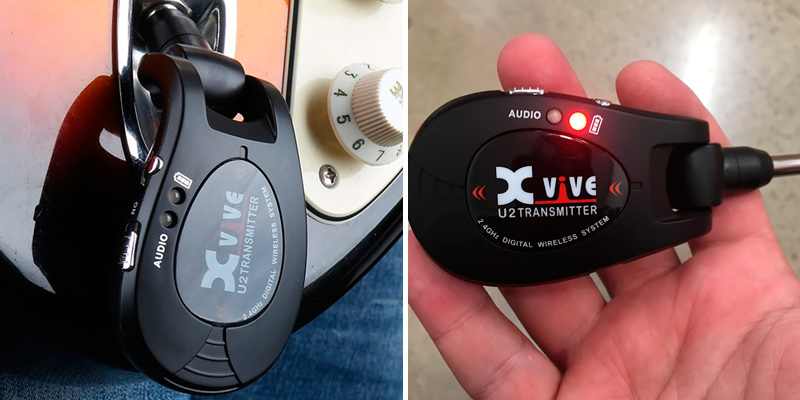
Identical Waveforms
Sound quality is subjective. Having said that, the fidelity difference is basically nonexistent here. Recording with DAW, the waveforms between the ones that this system produces and the ones you get from cables will look pretty much identical. Sure, some might feel the slightest reduction at the extreme frequency spectrum ends but this is not something that even trained ears will be able to pick up.
Likewise, with the latency capping at 5 milliseconds, the delay is virtually undetectable. The people behind this model are claiming that the transmission range will be able to cover at least 70 feet (~20 metres) and they can back up that claim, even with multiple obstacles (walls, furniture, even cars) between you and the receiver.
Long story short, the Xvive U2 Wireless Rechargeable Guitar System can be used straight from the box without reading the instructions. The system offers great build quality, great sound quality, and the usual convenience that you receive when you go wireless.

| Last updated price | £99.00 |
| Stock | In stock |
| ASIN | B01N4DSQBR |

Getaria GWS-28 Stereo Wireless
60 Metres of Transmission
Covering small acoustic shows, practising alone, jamming with bandmates, the Getaria GWS-28 Stereo Wireless Guitar System will support these endeavours with ease, and then some. First things first, this system can work with multiple instruments simultaneously, which is not its biggest strength, but that's the feature we always welcome with open arms when reviewing these systems. Bass guitars, acoustic guitars, electric guitars, keyboards, piano, drums, and more, GWS-28 can accommodate them all.
Shifting gears, again, this is not the system's biggest selling point, but we cannot say we dislike its appearance. In fact, both devices look stylish and even somewhat elegant, not unlike the awkward alternative that these systems are usually offering. The elongated, all-black design presents a pretty sleek front, while the multiple cutouts filled with LED lights make the transmitter and receiver look modern and expensive. They're low-profile lights, discreet and subtle, but quite powerful as well, so some might find them a little excessive in low-light conditions.
So, what is the most attractive attribute that this system is bringing to the table? Some would argue that it is the sound that delivers sharp highs and creeping lows. Some would argue that it is the accurate tonal balance. Some might assign its dynamic range this title. Reaching 105 decibels, the system lets you play at the highest volume without noticeable quality loss.
But we like the transmission range a little more. Sure, it is not quite as sexy as the sound quality attribute, but stretching 60 metres without leaving the budget price bracket is pretty incredible. You can play outdoors and even leave the stage knowing that the sound will follow you.

270-Degree Heads
Setting aside the transmission range, this system is not especially different from what Getaria is usually offering. The battery life, the company's signature strength, remains excellent, giving you ~7-8 hours on a single charge. Plus, the batteries recharge within ~90 minutes. The latency, capping at 12 milliseconds, is alright as well. The heads on both devices rotate 270 degrees, enabling easy manoeuvring.
Without discussing the carrier frequency and the frequency response that are standard here (2.4 GHz and 20 Hz - 20 kHz respectively), the Getaria GWS-28 Stereo Wireless Guitar System will not disappoint experienced musicians, especially those who frequent outdoor venues and like to move around during concerts.

| Last updated price | $0.00 |
| Stock | May be out of stock |
| ASIN | B08744ZCDV |

Getaria Built-in Rechargeable Lithium Battery
Full and Accurate Sound
The Getaria GWS-8 is a decent system that will accommodate beginners but not always the more experienced guitarists. The signal that both the transmitter and the receiver are offering is strong, enabling interference-free sound. But, at extreme volume and frequency limits, the noise becomes noticeable. Faint, but noticeable. Also, the model cannot promise latency below 12 milliseconds, so the delay will also be faint but noticeable.
That being said, aside from extreme cases, the sound will usually be transferred without substantial lag, remaining crisp even when you start playing complex compositions incorporating hard riffs as well as multiple variations. There's no tone or detail loss. The highs that are transferred through this system remain sharp, while the lows are as solid and creeping as they should be. Generally speaking, the music will sound full and accurate, with a good tonal balance that you normally get from cables. To add more, with the dynamic range exceeding 105 decibels, you can play at the maximum volume without quality loss.
Build-wise, both devices are pocket-sized, enabling comfortable transportation. They're made primarily from food-grade plastic, making the system pretty tough as well. What's more, the heads can be rotated 180 degrees, offering easy manoeuvring. Both the transmitter and the receiver come equipped with 1100-mAh rechargeable batteries, so they should usually last at least 8 hours on a single charge.
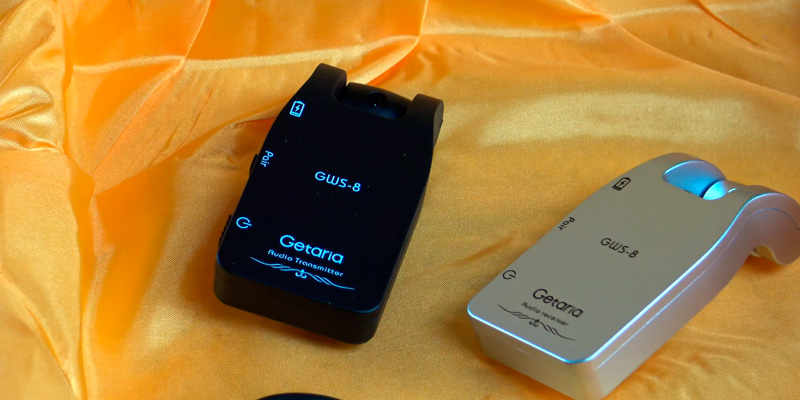
Six Devices at any One Time
At this price point, there are no miracles, meaning that the system makes a few questionable moves as well. The LED lights that start glowing once the devices are paired are bright and distracting. While the construction is generally sturdy, the USB ports are fragile, so proceed with caution when you recharge these devices.
On the plus side, the system comes with an integrated memory function, storing the previous pairing and ensuring automatic connection next time. In fact, with this system, six devices can be supported at any one time, so you can switch between multiple instruments and juggle even more equipment than necessary. Finally, the signal transfer length usually reaches 100 feet (30 metres), working through walls as well, though such obstacles reduce the distance to ~40 feet (~12 metres).
Bottom line, whilst 'purist' players might feel cheated with this system, the Getaria GWS-8 more than covers beginners' needs, ensuring respectable frequency response throughout the entire range and maintaining excellent tonal balance.

| Last updated price | £31.93 |
| Stock | In stock |
| ASIN | B07L5B64RG |
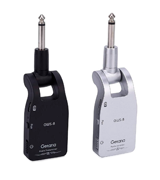
Ammoon Rechargeable 6 Channels Audio
Six Receivers Simultaneously
The Ammoon Wireless Guitar System accommodates class performances, friends gatherings, and live performance. We like this system plenty, even despite its middling battery life capping at ~4-5 hours. First and foremost, we like this one because the sound quality is excellent. The bass that they receive and transmit comes out with brilliant impact and respectable extension. There's almost no vocal masking. The highs are rolled off, so the music will not feel harsh, but since the system covers the default frequency response (20 Hz - 20 kHz), they also don't sound artificially closed-off. More often than not, the highs remain consistent, sharp but not screamy. Apart from that, the system transmits clean mids and rich lows. Also, removing cable tone simulation, what the people at Ammoon are offering here will be great with passive pickups. Both devices are even compatible with guitars that use a vibrato system.
Still, as much as we appreciate its performance, there's nothing unique about it. Wireless systems from Ammoon seldom disappoint on this front, so we've not necessarily told the people who used these systems before anything new. What is somewhat new, at least to those people who have not used the company's latest systems, is the fact that this one can transmit lossless sound to 6 receivers at the same time. Likewise, playing favourites with the number 6, this unit will let you switch between 6 channels on the 2.4 GHz band.

Ultra-Short Delay
Everything else that this system is offering is borrowed from the industry's most common playbook. The 24-bit/48KHz sample range ensures ultra-short delay. The signal-to-noise ratio is low, which means that even seasoned guitarists will not be able to tell the difference between this unit and wired systems. Both devices are made from high-strength plastic, so you can be pretty rough with them on the road knowing that the plastic will not start falling apart.
Again, the battery life is not great here, but you can charge both devices simultaneously, so that's something. There are LED indicators on the transmitter and receiver, letting you know when they're successfully paired. Veteran players might notice the 12-millisecond delay but this is what this price bracket usually demands.
So, provided you don't mind the mediocre battery life and the 12-millisecond latency, there's almost no side you'll regret going with the Ammoon Wireless Guitar System.

Additional Info
| Last updated price | £40.99 |
| Stock | May be out of stock |
| ASIN | B07L2RXYZL |

Rowin WS-20 Rechargeable
Black and Rose Gold
The Rowin WS-20 is a beauty. Mixing black and rose gold, both devices look blinding, housing plates that give them a brilliant vintage appearance. Whilst we will concede that aesthetics seldom sell these systems and, looking at the big picture, some might even call them irrelevant, but we appreciate the gesture nonetheless. Of course, we didn't add this unit to the list based on aesthetics alone, not even close. Also, whilst the system looks good, the build quality is not quite as great as you'd expect, so we're not necessarily giving the company full design credit here.
No, what sells the unit is its performance before anything else. Its performance includes the 24-bit/48KHz sample range that transmits audio with clarity. It also includes the frequency range that spans across the entire 20 Hz - 20 kHz territory. Whilst this is nothing that deserves parades, this is not quite the case with the system's latency. Capping at 4 milliseconds, the unit makes sure that even professionals will not be able to notice the slightest delay.
Removing these specs from the equation, the throughput is pretty brilliant as well, capturing the most subtle nuances and transmitting them with high fidelity. Assuming that you won't be playing around Wi-Fi routers, there will be no noticeable interference. The transmission range should usually stretch full 30 metres. But, as always, when there are obstacles between the instrument and the amp or pedal chain, the range starts shrinking.
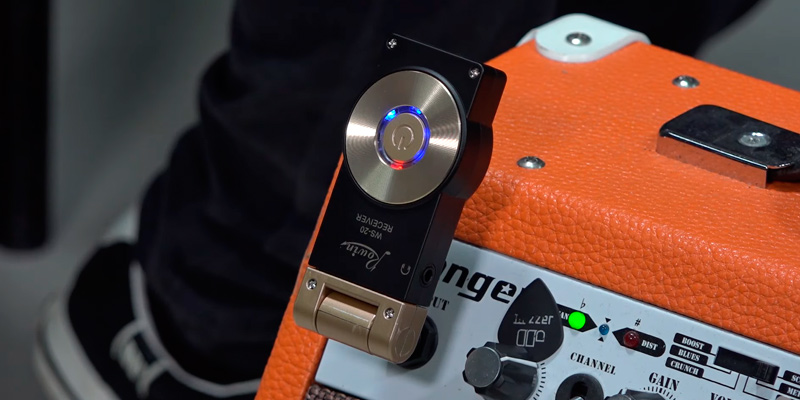
Headphones Out and Aux In
Considering that this unit is even more affordable than the already affordable systems that we've gathered here, certain drawbacks are inevitable. To name one, the plugs rotate 180 degrees, which is good but not quite as good as the ~280 degrees that the more expensive units are offering nowadays. To name more, whilst the battery life on both devices is above-average, usually pushing ~6 hours, the batteries take more than 2 hours to recharge, sometimes even 3.
That being said, the unit has its upsides as well. Aside from the practically nonexistent latency, its most attractive quality is the headphones output and the auxiliary input on the receiver and transmitter respectively. With these, the system can serve as a headphones amplifier.
All things considered, the people who can tell the difference between 4 and 12 milliseconds of delay and are working on a tight budget will have a hard time finding something better than the Rowin WS-20.
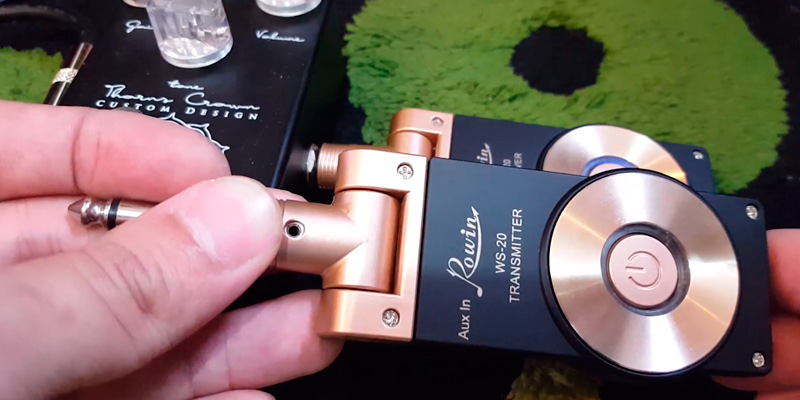
| Last updated price | $0.00 |
| Stock | May be out of stock |
| ASIN | B0711J6B3F |
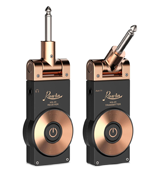
What Is a Wireless Guitar System?
Jamming with friends, experimenting at home, having a blast on stage, you can do so much with bass, acoustic, and electric guitars, and they ask so little in return. Besides the obvious maintenance demands, guitars usually like when you make the connection as wireless as possible, hence these wireless guitar systems.
With these systems, you can move around without worrying that you might snag or unplug something, damaging the instrument or the equipment piece that you were working with. Of course, just a few years ago, decent digital wireless systems used to cost an arm and a leg and the systems that were affordable introduced noticeable latency, meaning that even the least talented and experienced musicians could tell that there's a delay between the amp and the instrument.
Nowadays though, there are adequate systems that cost below 50 quid. Despite the almost laughable price, the receivers and transmitters that these systems are using reduce lag, eliminate noise, sure interference-free transmission, and make the output indistinguishable from the one that even the best wires are offering. Plus, the batteries inside these systems can usually work for ~8 hours straight on a single charge.
What Features to Compare
Wireless Carrier Frequency
Wireless guitar systems act on 2.4 GHz and 5.8 GHz bands. More often than not, the second option is the more preferable one since this is also the less occupied one. The potential interference sources on this band are reduced. Still, this will depend on the electronics surrounding you. Assuming that you're surrounded with multiple Wi-Fi routers or extenders that operate on the same band, you receive nothing but disadvantages from the second band.
Transmission Range
Wireless devices always have a limited signal transfer length. With the transmitters and receivers that constitute wireless guitar systems, the range usually hovers around 50-100 feet. As always, obstacles between you and the receiver can reduce the maximum available distance, sometimes substantially (50-100%), sometimes not quite as much.
Frequency Response
People who have hung around audio circles long enough inevitably come across the term frequency response. This is a loaded subject that we will not be explaining at great length here. In short, frequency response measures how good particular audio components are at reproducing audible frequencies within the advertised response. Setting aside deliberate EQ tweaks, perfect frequency output should be equal to the input. Otherwise, the signal is altered. The people around in the audio circles call this response 'flat', where fixed volume sine waves can be swept through the system and maintain the same amplitude at all frequencies at the output.
Since human hearing ranges from 20 Hz to 20 kHz, that's the response that most musical equipment pieces are covering. That said, while you might not be able to hear them, the frequencies above 20 kHz can add transience and rumble to the sound, making the music feel more impactful. Plus, without that inaudible range, the music can sometimes sound artificially closed-off.
Dynamic Range
Avoid systems that are not offering above 100 decibels on the dynamic range scale at all costs. Without exceptions, these systems make the sound flow blurry and inconsistent on high volumes. Adding insult to injury, they usually introduce drop-outs and squelching issues.
Extras
Setting aside performance, there are multiple factors contributing to increasing or decreasing wireless guitar systems' value. These include battery life (as well as the time the battery takes to go from 0 to 100%), input plugs, the ports, and the cables that usually come with the system.
Wired vs Wireless: Should You Lose the Cables?
Going cable-free or sticking with what's working is a much-debated topic among guitarists. While both affect the tone, this issue is more about application and signal flow. So, what are the upsides and downsides that both approaches entail?
Wired
With cables, screening is everything. Cheap cords will always introduce unwanted noise and buzz, so you need something with decent shielding. Shielding the conductors against electrical interference (using metal shields, plastic jackets, and insulation), high-quality cables are able to minimize noise. Still, when cables are unbalanced, you cannot escape the noise, so keep the cables away from potential interference sources (power supply units, radios, Wi-Fi routers, etc).
Second, do not forget capacitance. In a nutshell, capacitance is the cables' ability to store an electrical charge. With high-impedance equipment (like passive guitars), low capacitance gives you an improved frequency response. But, the longer the cable is, the higher is the capacitance and signal loss across its length. In other words, stick with the shortest cables that you can work with.
The last guest at this party is connectors. Needless to say, anything standing between you and the amp will have an effect on the sound quality, including connectors. This is not the most difficult part though. As long as you go with gold-plated connectors, you'll be fine since gold is an excellent electricity conductor. Also, gold-plated connectors do not corrode with time.
Wireless
The biggest issue with wireless systems is that the cheap ones are always colouring the tone. Working with companders that have a fixed ratio, they can make the output sound quite unnatural. These are not the systems that we're discussing here though. No, the systems that we've reviewed above come equipped with natural-sounding companders, so the difference between wired and wireless outputs becomes almost or, at times, 100% undetectable.
Cheap wireless systems are not an option. When you're on a strict budget, go with cables. That being said, these systems are becoming more and more affordable nowadays, so there are models that cost less than 50 bucks and sound almost indistinguishable from a wired connection. But, unlike with wires, these systems let you move around the stage as much as you want. As long as the AD/DA converters are good enough, the original tone will be maintained, and the output will sound completely natural.
Conclusion
Again, the 'application' part is everything here. Where you play, with whom you play, the frequency with which you travel, what the stages look like, and more, these factors will determine whether you should go cable-free or remain wired. Assuming that you have the financial means, we will recommend going wireless. Beginners and intermediate players can seldom tell the difference between the two anyway, so you might as well stick with what's more comfortable and convenient, which is always wireless systems more so than wired systems.




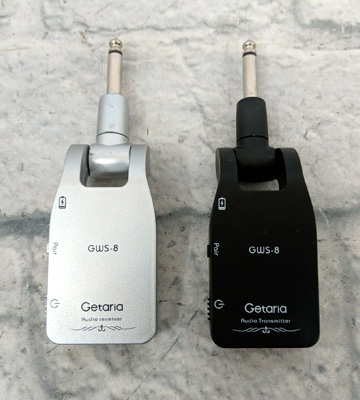
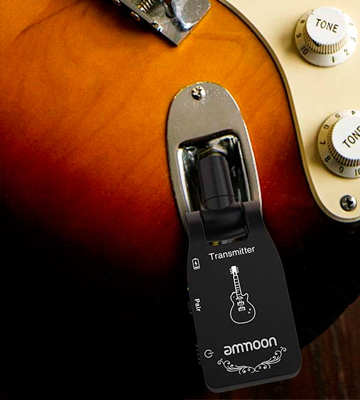


Your comment was successfully sent
Error! Please try again later